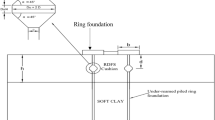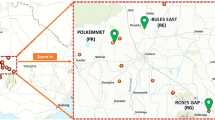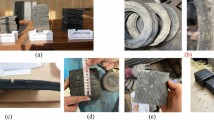Abstract
Railway ballast forms a major component of a conventional rail track and is used to distribute the load to the subgrade, providing a smooth running surface for trains. It plays a significant role in providing support for the rail track base and distributing the load to the weaker layer underneath. Ballast also helps with drainage, which is an important factor for any type of transportation structure, including railroads. Over time, ballast progressively deforms and degrades under dynamic loading and loses its strength. In this study, extensive laboratory tests were conducted to investigate the effect of load amplitude, geogrid position, and number of geogrid layers, thickness of ballast layer and clay stiffness on the behavior of the reinforced ballast layer and induced strains in a geogrid. A half full-scale railway was constructed for carrying out the tests, which consisted of two rails 800 mm in length with three wooden sleepers (900 mm × 10 mm × 10 mm). Three ballast thicknesses of 200, 300 and 400 mm were used in the tests. The ballast was overlying 500 mm thickness clay in two states, soft and stiff. The tests were carried out with and without geogrid reinforcement; the tests were performed in a well-tied steel box of 1.5 m length ×1 m width ×1 m height. Laboratory tests were conducted to investigate the response of the ballast and the clay layers where the ballast was reinforced by a geogrid. Settlement in ballast and clay, soil pressure and pore water pressure induced in the clay were measured in reinforced and unreinforced ballast cases. It was concluded that the amount of settlement increased as the simulated train load amplitude increased, and there was a sharp increase in settlement up to cycle 500. After that, there was a gradual increase that leveled out between, 2500 to 4500 cycles depending on the frequency used. There was a slight increase in the induced settlement when the load amplitude increased from 0.5 to 1 ton but it was higher when the load amplitude increased to 2 tons. The increased amount in settlement depended on the existence of the geogrid and other parameters studied. The transmitted average vertical stress for ballast thicknesses of 30 cm and 40 cm increased as the load amplitude increased, regardless of the ballast reinforcement for both soft and stiff clay. The position of the geogrid had no significant effect on the transmitted stresses. The value of the soil pressure and pore water pressure on ballast thicknesses of 20 cm was higher than for 30 cm and 40 cm thicknesses. This meant that the ballast attenuated the induced waves. The soil pressure and pore water pressure for reinforced and unreinforced ballast was higher in stiff clay than in soft clay.
Similar content being viewed by others
References
Abebe MS, Qiu HS (2016), “Numerical Modeling of Geotextile Reinforcement of Soft Subgrade Ballasted Railway under High Speed Train,” Electronic Journal of Geotechnical Engineering EJGE, 21: 4227–4343.
ASTM D 2435-96, “Standard Test Method for One-Dimensional Consolidation Properties of Soils,” Reprinted from the Annual Book of ASTM Standards. Copyright ASTM, 4(8).
Awoleye EOA (1993), “Ballast Type-Ballast Life Predictions,” Derby, British Rail Research LR CES 122, October 1993.
Chen C (2013), “Discrete Element Modellingof Geogrid-Reinforced Railway Ballastand Track Transition Zones,” Ph.D. Thesis, University of Nottingham, UK.
Fattah MY, Mahmood MR and Aswad MF (2017), “Experimental and Numerical Behavior of Railway Track Over Geogrid Reinforced Ballast Underlain by Soft Clay,” Proceedings of the 1st GeoMEast International Congress and Exhibition, Egypt 2017 on Sustainable Civil Infrastructures, Recent Developments in Railway Track and Transportation Engineering, 14: 1–26.
Hayano K, Ishii K and Muramoto K (2013), “Effects of Ballast Thickness and Tie-tamper Repair on Settlement Characteristics of Railway Ballasted Tracks,” The 18th International Conference on Soil Mechanics and Geotechnical Engineering, Paris, 1275–1282.
Heidari M and El Naggar MH (2010), “Using Reinforced Soil Systems in Hammer Foundations,” Proceedings of the Institution of Civil Engineers, Ground Improvement, 163: 121–132.
Hussaini SKK (2013), “An Experimental Study on the Deformation Behavior of Geosynthetically Reinforced Ballast,” Ph.D. Thesis, University of Wollongong, Australia.
Leshchinsky B and Ling HI (2013), “Numerical Modeling of Behavior of Railway Ballasted Structure with Geocell Confinement,” Geotextiles and Geomembranes Journal, 36: 33–43.
Li D, Hyslip J, Sussmann T and Chrismer S (2016), Railway Geotechnics, E-book, Taylor and Francis Group, LLC.
Linlin G, Guanlin Y, Zhen W, Xianzhang L and Feng Z (2017), “Settlement Mechanism of Piled-Raft Foundation due to Cyclic Train Loads and its Countermeasure,” Earthquake Engineering and Engineering Vibration, 16(3): 499–511. https://doi.org/10.1007/s11803-017-0403-z.
Nareeman BJ and Fattah MY (2012), “Effect of Soil Reinforcement on Shear Strength and Settlement of Cohesive-Friction Soil,” International Journal of Geomate, 3: 308–313. Geotec., Construction Material and Environmental, Japan.
Navaratnarajah, SK, Indraratna B and Nimbalkar S (2016), “Application of Shock Mats in Rail Track Foundation Subjected to Dynamic Loads,” Procedia Engineering, 143: 1108–1119.
Advances in Transportation Geotechnics 3. The 3rd International Conference on Transportation Geotechnics (ICTG 2016)
Palmeira EM and Antunes LGS (2010), “Large Scale Tests on Geosynthetic Reinforced Unpaved Roads Subjected to Surface Maintenance,” Geotextiles and Geomembranes, 28: 547–558.
Paute JL, Hornych P and Benaben JP (1996), “Repeated Load Triaxial Testing of Granular Materials in the French Network of Laboratories des Ponts et Chausseés,” Flexible Pavements, Proc., European Symposium Euroflex 1993, A. G.Correia, ed., Balkema, Rotterdam, the Netherlands, 53–64.
Profillidis, VA, (2000), Railway Engineering, Aldershot: Ashgate Publishing Limited.
Raymond GP (2001), “Reinforced Ballast Behavior Subjected to Repeated Loading”, Geotextiles and Geomembranes, 20: 39–61.
Remennikov AM and Kaewunruen S (2008), “A Review of Loading Conditions for Railway Track Structures due to Train and Track Vertical Interaction,” Structural Control and Health Monitoring, 15: 207–234. DOI: 10.1002/stc.227.
Selig ET and Waters JM (1994), Track Geotechnology and Substructure Management, 1st Ed., Technology Development and Application Committee, on behalf of the Railways of Australia.
Wayne M, Fraser I, Reall B and Kwon J (2013), “Performance Verification of a Geogrid Mechanically Stabilized Layer,” ,Paris, 1381–1384.
Author information
Authors and Affiliations
Corresponding author
Rights and permissions
About this article
Cite this article
Fattah, M.Y., Mahmood, M.R. & Aswad, M.F. Stress distribution from railway track over geogrid reinforced ballast underlain by clay. Earthq. Eng. Eng. Vib. 18, 77–93 (2019). https://doi.org/10.1007/s11803-019-0491-z
Received:
Accepted:
Published:
Issue Date:
DOI: https://doi.org/10.1007/s11803-019-0491-z




